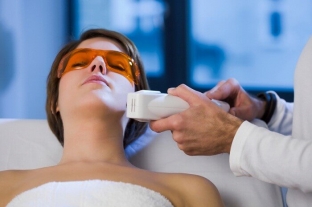Sunlight is known to have a beneficial effect on the course of some dermatoses, which is explained by the effect of ultraviolet radiation on the skin. Ultraviolet rays on the scale of electromagnetic waves occupy an intermediate position between the visible spectrum and x-rays. So, in the treatment of atopic dermatitis, narrow-wave phototherapy is used, which brings a positive effect. How is the procedure for treating atopic dermatitis with UV radiation, what side effects and measures to prevent them, read further on estet-portal.com.
Ultraviolet radiation in the treatment of atopic dermatitis
UVA and UVB spectra UV – radiation.
Wavelength determines its penetrating power, which is important when prescribing the treatment of dermatoses, including the treatment ofatopic dermatitisThus, medium-wave rays reach the horny and spiny layers of the dermis, and long-wave rays reach the papillary and reticular layers of thedermis
. There is a lot of information in the literature about the effect of solar radiation on the body. For example, under the action of long-wave radiation on a cell, growth inhibition and respiratory activity are inhibited, DNA synthesis also changes, notes estet-portal.com. Some authors claim that UV – radiation affects lipido – photolabile components by peroxidation. UV – radiation affects the immune system by changing the quantitative content of Langerhans cells. There are 4 types of phototherapy in the treatment of atopic dermatitis and other skin diseases:
selective phototherapy – combination of medium wave radiation with long wave;
- narrow-wave UVB – phototherapy with maximum emission at wavelength;
- photochemotherapy – combined use of long-wave irradiation with photosensitizers; phototherapy
- using longwave UV – narrow spectrum exposure.
 Aspects of UV treatment of atopic dermatitis
Aspects of UV treatment of atopic dermatitis
Some authors point to the effectiveness of the use of general photochemotherapy in the treatment of atopic dermatitis, which is based on a long-wavelength spectrum of cure in combination with the ingestion of furocoumarin preparations.
Recent scientific studies have shown that 311nm wavelengths have an optimal therapeutic effect in the treatment of atopic dermatitis with minimal erythema.
In general radiation booths, where the lamps are placed vertically, the patient receives the radiation while standing. In places with horizontal lamps, the patient takes the procedure lying down. However, when treating atopic dermatitis with phototherapy, adverse reactions are possible.
These include the appearance of a yellow skin tone, lentigo, uneven pigmentation,
telangiectasias,as well as thickening of the skin, decreased turgor, dehydration of the skin. The above features have the common name – photoaging of the skin.
Therefore, in the treatment of atopic dermatitis using phototherapy, it is necessary to intensively moisturize the skin with hydrating agents of medical cosmetics, which will restore the hydrolipidic mantle of the skin. The composition of these preparations should include moisturizing ingredients such as glycerin, shea butter, linoleic acid.
It is also necessary that the composition of the cosmetic product in the treatment of atopic dermatitis should contain substances that accelerate the processes of skin regeneration (aloe extract), anti-inflammatory agents and antioxidants. In the recovery period after the treatment of atopic dermatitis with phototherapy, the use of antioxidant drugs is necessary.







Add a comment